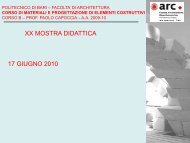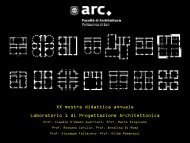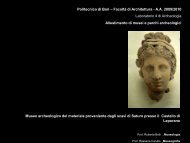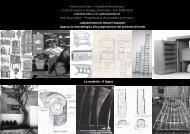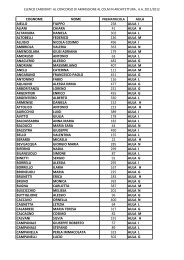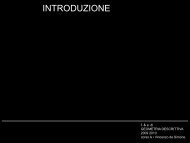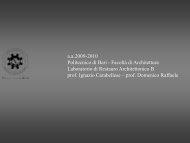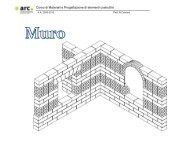PresentazionePresentazioneLa Facoltà <strong>di</strong> Architettura del <strong>Politecnico</strong> <strong>di</strong> <strong>Bari</strong> - l’unica inItalia che organizza gli stu<strong>di</strong> esclusivamente su cinque anni econ organizzazione annuale dei corsi - dall’A. A. 2005-2006prevede due in<strong>di</strong>rizzi: uno <strong>di</strong> Architettura (CdLs inArchitettura) “generale” ed uno “classico”. L’in<strong>di</strong>rizzo“classico” propone un corso <strong>di</strong> stu<strong>di</strong> che, se da un lato siispira a tra<strong>di</strong>zioni <strong>di</strong> stu<strong>di</strong> consolidate nel mondo germanicotra xix e xx secolo, non ha attualmente confronti nelpanorama internazionale delle facoltà <strong>di</strong> architettura, siaitaliane che estere.La laurea in architettura con in<strong>di</strong>rizzo “classico”L’in<strong>di</strong>rizzo classico è volto non soltanto alla formazione <strong>di</strong>una figura professionale che integri le cognizioni <strong>di</strong> basedell’architetto, così come è definito dalle recenti <strong>di</strong>rettivenazionali ed europee, con specifiche conoscenze nell’areadell’antico, a carattere storico, archeologico e metodologico;ma anche – più in generale – a riproporre la figura <strong>di</strong> unarchitetto ‘colto’, in sostanziale controtendenza con gliattuali programmi formativi, sempre più attenti agli effimerifermenti della quoti<strong>di</strong>anità e sempre meno interessati aduna formazione culturale organica.ObiettiviObiettivo dell’in<strong>di</strong>rizzo “classico” è la creazione <strong>di</strong> una figuraprofessionale, <strong>di</strong> fatto assente nel panorama accademicoitaliano, che potremmo definire ‘architetto-archeologo’.Tale termine, infatti, rende assai bene l’immagine <strong>di</strong> unarchitetto la cui adeguata conoscenza degli aspetti storici earcheologici del mondo antico, insieme con <strong>il</strong> contatto<strong>di</strong>retto con l’architettura derivante dall’attiva partecipazionea campagne <strong>di</strong> r<strong>il</strong>ievo e <strong>di</strong> scavo, consentono <strong>di</strong> intervenirecon consapevolezza sul patrimonio archeologico emonumentale, affiancando e integrando le competenzedegli archeologi con i quali è chiamato a collaborare, sia aifini della conoscenza, sia della conservazione, sia dellaprogettazione infrastrutturale e d’area.Obiettivo collaterale, ma non per questo meno r<strong>il</strong>evante, èquello <strong>di</strong> restituire alla figura dell’architetto quel bagaglio <strong>di</strong>conoscenze umanistiche, oltre che tecnico–scientifiche eoperative, in grado <strong>di</strong> elevarlo al <strong>di</strong> sopra <strong>di</strong> quella figurameramente tecnico–professionale che pure oggi, nelmigliore dei casi, sembra essere l’obiettivo ultimo dellaformazione universitaria.Sbocchi professionaliL’estrema ricchezza del patrimonio archeologico del nostroPaese e la r<strong>il</strong>evanza che questo assume nel quadroeconomico generale determinano negli organi preposti allasua salvaguar<strong>di</strong>a una forte esigenza <strong>di</strong> interlocutoriadeguati; la creazione <strong>di</strong> una figura professionale preparataad affrontare le specifiche problematiche dell’antico è quind<strong>il</strong>argamente auspicata. Al tempo stesso, la formazionenell’ambito dell’in<strong>di</strong>rizzo classico garantisce l’acquisizionedelle cognizioni necessarie ad operare, al pari dell’architettotra<strong>di</strong>zionale, nei <strong>di</strong>versi settori peculiari della <strong>di</strong>sciplinasenza penalizzare in alcun modo l’accesso agli usualisbocchi professionali.InternazionalizzazioneLa ricchezza del patrimonio archeologico nazionale trovad’altronde confronto in molti altri Paesi me<strong>di</strong>terranei, primi,tra gli altri, Grecia e Turchia, ma anche Cipro, Siria,Giordania, Israele, Egitto, Libia, Tunisia, Algeria, Marocco,Spagna, Francia, Albania, Romania; sim<strong>il</strong>i sono quin<strong>di</strong> leproblematiche che gli organi preposti alla conservazione deipatrimoni archeologici e monumentali <strong>di</strong> quei Paesi sitrovano ad affrontare.Non <strong>di</strong>versamente dall’Italia, nessuno dei Paesi citati hapotuto o voluto formare una figura professionale idonea a<strong>di</strong>ntervenire nello specifico settore dell’antico; in questosenso <strong>il</strong> curriculum classico, proprio per l’unicità delprocesso formativo proposto, ambisce a <strong>di</strong>venire unriferimento anche all’esterno del quadro formativonazionale, pre<strong>di</strong>sponendosi, a livello istitutivo, ad accoglieree a formare nuclei <strong>di</strong> studenti stranieri.Specificità nella formazione dell’architetto-archeologo- ricostituzione <strong>di</strong> una cultura complessiva dell’antico (corsi<strong>di</strong> storia, storia dell’arte antica, archeologia)- ricomposizione dell’organicità della formazioneumanistico-scientifica propria dell’architetto (corsi storicoarcheologicie <strong>di</strong> scienza dell’antichità, ristrutturazione delle<strong>di</strong>scipline scientifiche <strong>di</strong> base)- recupero <strong>di</strong> ab<strong>il</strong>ità specifiche nel settore dellarappresentazione (schizzo a mano libera, <strong>di</strong>segno dal vero er<strong>il</strong>ievo manuale quali strumenti <strong>di</strong> analisi dell’architettura)- conoscenza e padronanza delle nuove tecnologie (sistemi<strong>di</strong> r<strong>il</strong>evamento strumentale, rappresentazione emodellazione, metodologie <strong>di</strong> indagine non <strong>di</strong>struttiva)- acquisizione delle metodologie <strong>di</strong> indagine archeologica edelle scienze applicate all’archeologia quali strumenti per laconoscenza analitica dell’antico (metodologia della ricercaarcheologica, archeometria, geologia, metodologie <strong>di</strong> analisiambientale)- stu<strong>di</strong>o dell’architettura attraverso <strong>il</strong> contatto <strong>di</strong>retto con glie<strong>di</strong>fici antichi (viaggi <strong>di</strong> stu<strong>di</strong>o integrati all’osservazione e al<strong>di</strong>segno dal vero)- tirocini e attività sul campo (partecipazione a campagne <strong>di</strong>scavo e <strong>di</strong> r<strong>il</strong>ievo integrate alla documentazione <strong>di</strong> r<strong>il</strong>ievo, ealla conseguente lettura e interpretazione dell’architettura)Le missioni archeologicheAttualmente la Facoltà è impegnata in varie missioni <strong>di</strong>r<strong>il</strong>ievo e stu<strong>di</strong>o dei monumenti antichi in <strong>di</strong>verse aree delMe<strong>di</strong>terraneo, tra queste Taranto e Crotone in Italiameri<strong>di</strong>onale, Kos e Gortina <strong>di</strong> Creta in Grecia, Leptis Magnain Libia, Althiburos in Tunisia.Il nuovo curriculum potrà naturalmente trarre profitto dalleattività <strong>di</strong> ricerca già avviate o in procinto <strong>di</strong> esserlo:- Crotone, Santuario <strong>di</strong> Hera Lacinia a Capo Colonna.- Taranto, sito <strong>di</strong> Torre Saturo- Kos, area archeologica <strong>di</strong> ‘Città Murata’.- Gortina <strong>di</strong> Creta, l’area del ‘Pretorio’- Leptis Magna, area del Foro Vecchio.- Althiburos, <strong>il</strong> teatro romano.
PresentationThe Faculty of Architecture at the <strong>Politecnico</strong> <strong>di</strong> <strong>Bari</strong> is theonly Architecture School in Italy to organise stu<strong>di</strong>es ofArchitecture exclusively over five years and with annualorganization of courses. From the Academic Year 2005-2006the Faculty accompanies the “general” curriculum of theDegree Course in Architecture with the “classical” curriculum,proposing a course, which wh<strong>il</strong>e inspired by a tra<strong>di</strong>tion ofstu<strong>di</strong>es consolidated in the Germanic world between theNineteenth and Twentieth Centuries, has no actualcomparison in the international panorama of the Faculties ofArchitecture.The Degree in architecture through the classical curriculumThe classical curriculum is aimed not only at the training of aprofessional figure that integrates the basic knowledge of thearchitect, as defined by recent national and European<strong>di</strong>rectives, with specific knowledge in the area of the ancientworld, historic, archaeological and methodological incharacter; but also–more in general– to re-propose the figureof the ‘cultivated ’architect, substantially against the trend ofthe current training programmes, paying ever more attentionto the ephemeral da<strong>il</strong>y ferment and showing ever lessinterest in organic cultural training.ObjectivesThe objective of the classical curriculum is the creation of aprofessional figure, absent in the Italian academic panorama,that can be defined as an ‘architect-archaeologist’.This term, in fact, renders very well image of architects whosegood knowledge of the historic and archaeological aspects ofthe ancient world, together with <strong>di</strong>rect contact witharchitecture derived from active participation in survey andexcavation campaigns, allow them to intervene withawareness of the archaeological and monumental heritage,accompanying and integrating with the competence of thearchaeologists with whom they w<strong>il</strong>l be called on tocollaborate, in terms of knowledge and conservation as wellas planning the infrastructure and the areas.A collateral objective, but by no means less relevant, is thatof restoring to the figure of the architect that baggage ofhumanistic knowledge, in ad<strong>di</strong>tion to the technical-scientificand operative, in order to elevate him or her above themerely technical-professional figure that even today, in thebest of cases, seems to be the ultimate objective of universitytraining.Professional opportunitiesThe extreme wealth of the archaeological heritage of ourcountry and the relevance that it assumes in the generaleconomic picture determine a great need for adequateinterlocutors in the organisations involved in its safeguar<strong>di</strong>ngin Italy. The creation of a professional figure prepared toconfront the specific problems of the ancient world istherefore widely welcome. At the same time, training in theenvironment of the classic area guarantees the acquisition ofthe cognitions necessary to operate, at the level of thetra<strong>di</strong>tional architect, In the <strong>di</strong>fferent particular sectors of the<strong>di</strong>scipline without penalising in any way access to the usualprofessional opportunities.InternationalisationThe wealth of the national archaeological heritage in Italyfinds comparison in many other Me<strong>di</strong>terranean countries,first among these Greece and Turkey, but also Cyprus, Syria,Jordan, Israel, Egypt, Libya, Tunisia, Algeria, Morocco, Spain,France, Albania, Romania. Therefore the problems faced bythe organisations involved in the conservation ofarchaeological and monumental heritage are sim<strong>il</strong>ar.No <strong>di</strong>fferently to Italy, none of these countries cited has beenable to or wanted to train a suitable professional figure tointervene in the specific sector of antiquity. In this sense theclassic curriculum, because of the unique nature of thetraining process proposed, aims to become a point ofreference also beyond the national training framework,pre<strong>di</strong>sposed at an institutional level, to welcome and traingroups of foreign students.Specific training of the architect -archaeologist- reconstitution of a comprehensive culture of the ancient(courses in history, history of ancient art, archaeology)- re-composition of the organic nature of the humanisticscientifictraining of the architect (courses in the history ofarchaeology and the science of antiquity, restructuring of thebasic scientific <strong>di</strong>sciplines)- recovery of specific sk<strong>il</strong>ls i the sector of representation (freesketching, life drawing and manual surveying that are thetools of the analysis of architecture)- knowledge and mastery of new technologies (instrumentalmeasuring systems, representation and modelling, nondestructive survey methodologies)- acquisition of archaeological investigation methodology andthe sciences applied to archaeology as tools for analyticalknowledge of the ancient (archaeological research methodology,archaeometry, geology, environmental analysis methodology)- study of architecture through <strong>di</strong>rect contact with ancientbu<strong>il</strong><strong>di</strong>ngs (study trips integrated with observation and lifedrawing)- work experience and field activities (participation inexcavation and survey campaigns integrated with surveydocumentation, and the consequent rea<strong>di</strong>ng an<strong>di</strong>nterpretation of architecture)Archaeological missionsCurrently the Faculty is involved in various survey and studymissions of ancient monuments in <strong>di</strong>verse areas of theMe<strong>di</strong>terranean, inclu<strong>di</strong>ng Taranto and Crotone in the South ofItaly, Kos and Gortina on Crete in Greece, Leptis Magna inLibya and Althiburos in Tunisia.The new curriculum w<strong>il</strong>l naturally be able to benefit from theresearch activities already underway or soon to be started:- Crotone, Sanctuary of Hera Lacinia in Capo Colonna.- Taranto, site of Torre Saturo- Kos, archaeological area of the ‘Walled City’.- Gortina in Crete, the area of the ‘Praetorium’- Leptis Magna, area of the Old Forum.- Althiburos, the Roman theatre.
- Page 1: 0607Politecnico di BariFacoltà di
- Page 4 and 5: Politecnico di Bari, Facoltà di Ar
- Page 6 and 7: 4. Regolamenti didattici4.1. Il Reg
- Page 11 and 12: Le strutture didattiche e di suppor
- Page 13 and 14: giorno e dando, quindi, esecutivit
- Page 15 and 16: • esprimere pareri sui compiti di
- Page 17 and 18: 1.3. La Biblioteca di FacoltàIl pa
- Page 19 and 20: 2. Strutture di ricerca e di suppor
- Page 21 and 22: BIO 07, Ecologia43 Mariavaleria Min
- Page 23 and 24: le richieste e le iniziative ad ess
- Page 25: 2.3 Le biblioteche d’area2.3.1 Le
- Page 28 and 29: 33. La didattica e gli studenti263.
- Page 31 and 32: 4. I Regolamenti didattici4.1. Rego
- Page 33 and 34: presente regolamento;• le propede
- Page 35 and 36: discussi ed i voti finali.Per ciasc
- Page 37 and 38: 4.2.4 Definizione delle aree discip
- Page 39 and 40: laurea da attivare in base al numer
- Page 41 and 42: non venga superato l’iscrizione a
- Page 43 and 44: Manifesto del CdLs in Architettura
- Page 45 and 46: Manifesto del CdLm in Architettura
- Page 47 and 48: ciclo provenendo da altri Atenei.È
- Page 49 and 50: Manifesto del CdLs in Architettura
- Page 51 and 52: Manifesto del CdLm in Architettura
- Page 53 and 54: Insegnamenti ssd Crediti Laboratori
- Page 55 and 56: Insegnamenti ssd Crediti Laboratori
- Page 57 and 58: Insegnamenti attivati e docenti per
- Page 59 and 60:
Insegnamenti attivati e docenti per
- Page 61 and 62:
Finalità e contenuti disciplinariN
- Page 63 and 64:
Lezioni- L’architettura etrusca e
- Page 65 and 66:
ibliografiche, volte ad acquisire g
- Page 67 and 68:
Discipline tecnologiche per l’Arc
- Page 69 and 70:
Istituzioni di geometria I + Istitu
- Page 71 and 72:
architettonicoTopicsLife drawing, u
- Page 73 and 74:
• Representation of the shadows
- Page 75 and 76:
frequenza del corso che consentel
- Page 77 and 78:
capacità di valutazione storico-cr
- Page 79 and 80:
scale edilizie e tra diversi tipi;
- Page 81 and 82:
planning of Roman suburban andcount
- Page 83 and 84:
mutation through the works of the p
- Page 85 and 86:
-Equazioni indefinite di equilibrio
- Page 87 and 88:
coerenza tra qualità funzionale, c
- Page 89 and 90:
transformations (psychrometry).In t
- Page 91 and 92:
madrepatria.4. La colonizzazione e
- Page 93 and 94:
EtruscologiaEtruscologyL-ANT/07 - 4
- Page 95 and 96:
Archeologia e Storia dell’Arte Ro
- Page 97 and 98:
The student will develope the archi
- Page 99 and 100:
tanto il rapporto tra elementi, str
- Page 101 and 102:
sociale dell’abitare (Loos, Tesse
- Page 103 and 104:
experimental research into the beha
- Page 105 and 106:
Articolazione dell’attività dida
- Page 107 and 108:
Aims and contentsThe Urban Sociolog
- Page 109 and 110:
nell’ambito dell’annuale “mos
- Page 111 and 112:
di laurea. Sarà quindi necessario
- Page 113 and 114:
- Ancient modern Rome: the continui
- Page 115 and 116:
During the lessons, theoretical and
- Page 117 and 118:
Le esercitazioni costituiscono lo s
- Page 119 and 120:
typological and technical innovatio
- Page 121 and 122:
• la fenomeni di propagazione del
- Page 123 and 124:
Aims and contentsThe urban economy,
- Page 125 and 126:
value of a civil apartment with the
- Page 127 and 128:
l’elaborazione della tesi di rice
- Page 129 and 130:
4.3.8 Esame di laureaPer essere amm
- Page 131 and 132:
semestrale• Laboratori di sintesi
- Page 133 and 134:
4.3.14 Manifesto del CdL in Disegno
- Page 135 and 136:
4.3.16 Organizzazione delle attivit
- Page 137 and 138:
4.3.17 Insegnamenti e docenti per a
- Page 139 and 140:
Laboratorio di Disegno industriale
- Page 141 and 142:
• metodo dell’assonometria;•
- Page 143 and 144:
fine dell’Ottocento; le avanguard
- Page 145 and 146:
Iscrizione al corsoLe iscrizioni av
- Page 147 and 148:
Laboratorio di Arredamento 2/IInter
- Page 149 and 150:
Disegno 2/IIDrawing 2/IIIcar 17-5 c
- Page 151 and 152:
communication, as follows:• typog
- Page 153 and 154:
4.3.22 Progetti didattici3° anno
- Page 155 and 156:
sintetiche, segnaletica interna ed
- Page 157:
esercitazioni pratiche, attività d
- Page 160 and 161:
55. Relazioni internazionali1585.1
- Page 163 and 164:
6. Post Lauream6.1. Dottorato di Ri
- Page 165 and 166:
Attività di ricercaLo svolgimento
- Page 167 and 168:
particolari e specifiche competenze
- Page 169 and 170:
iscrizione all’esame di ammission
- Page 171 and 172:
scientifico-disciplinare in cui è
- Page 173:
• alla sicurezza statica (corrett
- Page 176 and 177:
a.1 Planimetria del campus epiante
- Page 178 and 179:
Status accademico dei docentiDocent
- Page 180 and 181:
aAppendici178A.3 Indice dei nomiAAc
- Page 182 and 183:
aAppendicia.5 Calendario annuale de




